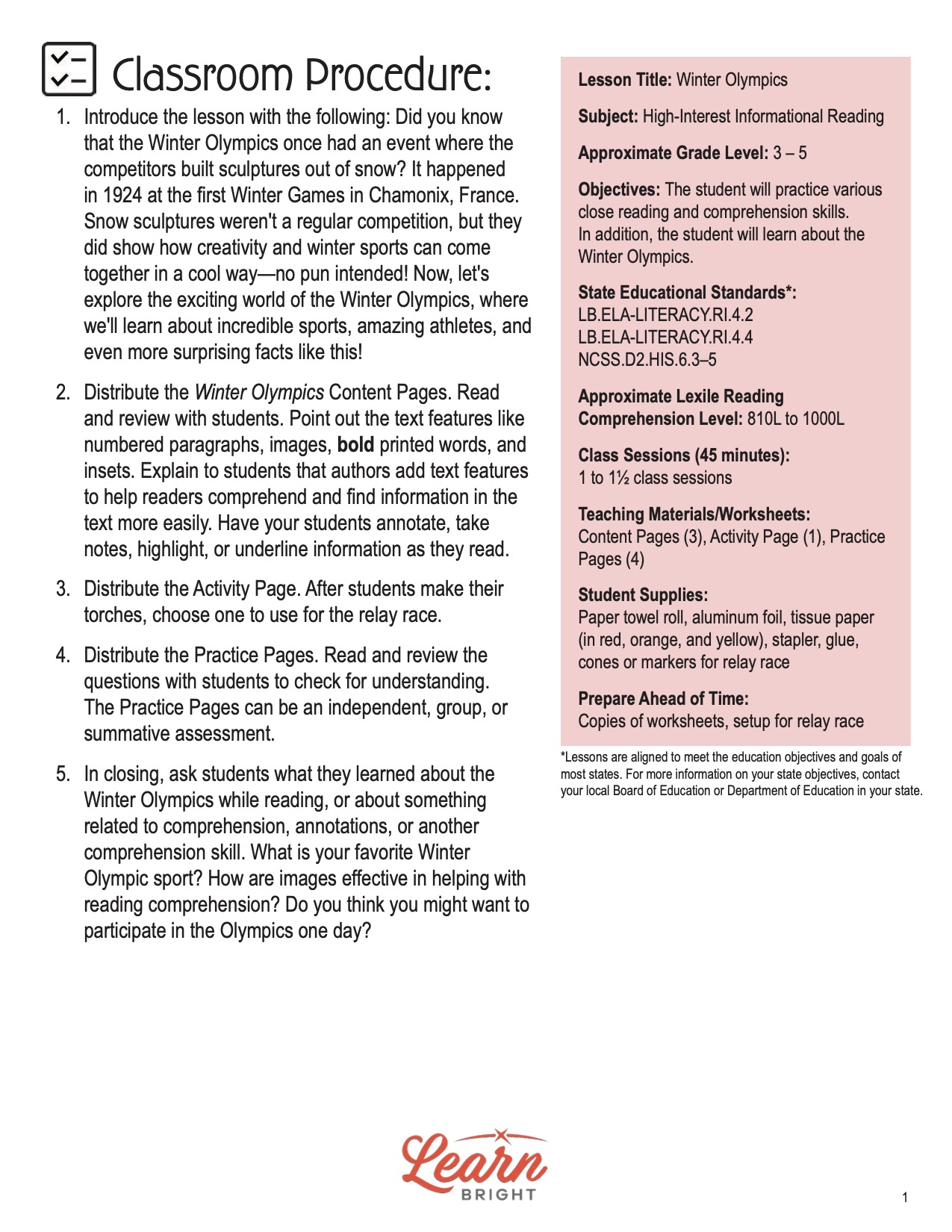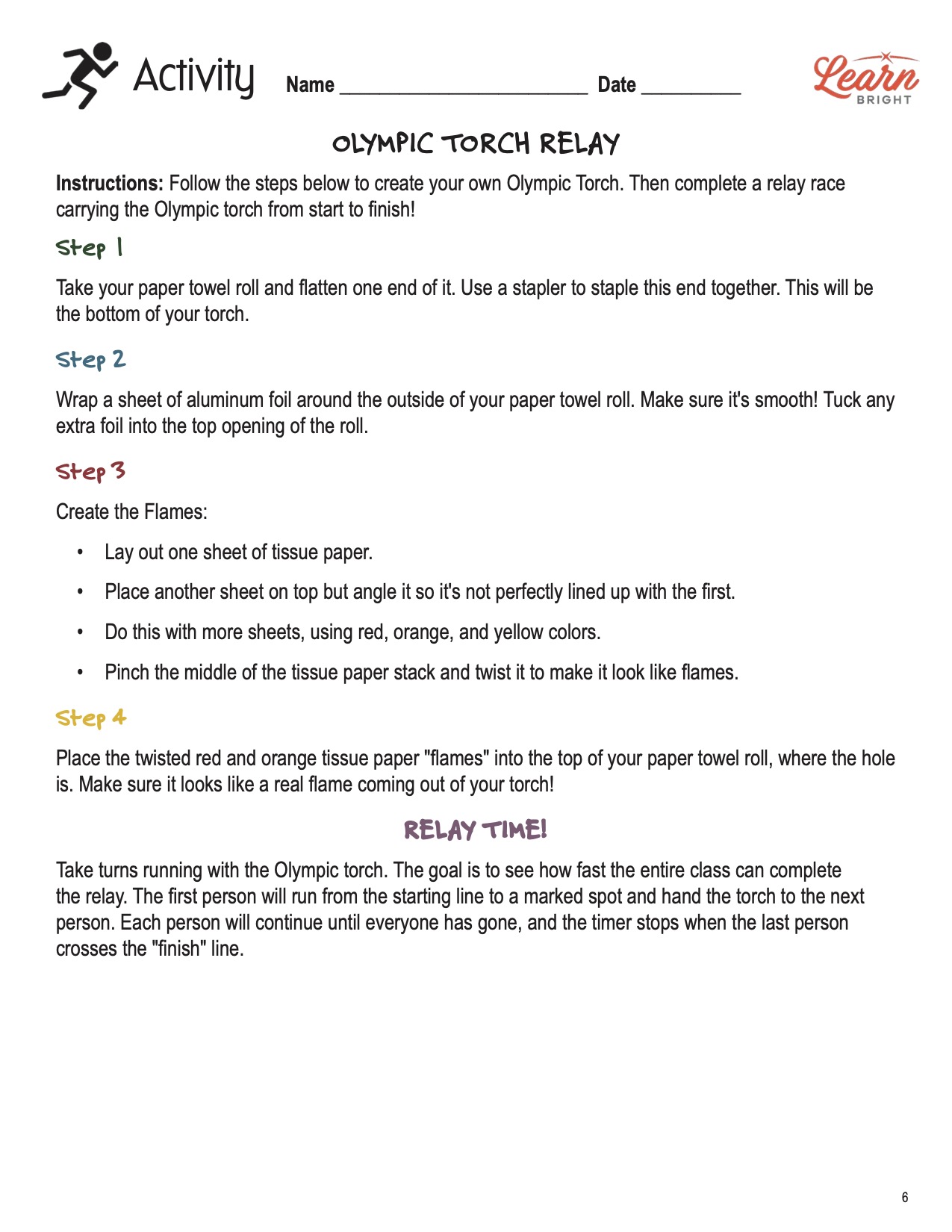Description
What our Winter Olympics lesson plan includes
Lesson Objectives and Overview: Winter Olympics is a high-interest reading comprehension lesson plan. As such, students will practice various close reading and comprehension skills. In addition, they will will learn about the Winter Olympic Games. This lesson is for students in 3rd grade, 4th grade, and 5th grade.
Classroom Procedure
Every lesson plan provides you with a classroom procedure page that outlines a step-by-step guide to follow. You do not have to follow the guide exactly. The guide helps you organize the lesson and details when to hand out worksheets. It also lists information in the yellow box that you might find useful. You will find the lesson objectives, state standards, and number of class sessions the lesson should take to complete in this area. In addition, it describes the supplies you will need as well as what and how you need to prepare beforehand. Some of the supplies you’ll need for the activity include paper towel rolls, aluminum foil, tissue paper (in red, orange, and yellow), and markers of some kind for the relay race.
Teacher Notes
The teacher notes page provides an extra paragraph of information to help guide the lesson and remind you what to focus on. It explains that you can teach this lesson in a whole-class setting or as an independent, small-group activity. The blank lines on this page are available for you to write out thoughts and ideas you have as you prepare the lesson.
WINTER OLYMPICS LESSON PLAN CONTENT PAGES
History of Winter Olympics
The Winter Olympics lesson plan contains three content pages. The Winter Olympics is a worldwide sports event that happens every four years. It brings together athletes from all over the world to compete in various winter sports. The Olympics is one of the oldest sporting traditions in the world, with a history that dates back to ancient Greece. The first ancient Olympic Games were held in Olympia, Greece, nearly 3,000 years ago in 776 BCE. These games were held in honor of the Greek god Zeus and included events like running, wrestling, and chariot racing.
The ancient Olympics continued for centuries until they were banned in 393 CE by the Roman Emperor Theodosius I. The games then disappeared for over a thousand years. It wasn’t until the late 19th century that the Olympic Games returned. We credit a Frenchman named Pierre de Coubertin with bringing them back to life. He believed that sports could promote peace and unity among different countries. To honor the origination of the very first Olympics, the first modern Olympic Games took place in 1896 in Athens, Greece. And the first Winter games took place in Chamonix, France, 28 years later in 1924.
Since then, the Winter Olympics occur every four years in different cities worldwide. For example, Beijing, China, hosted the games in 2022. In 2026, the games will move to Milan-Cortina, Italy. Then, in 2034, they will be in Salt Lake City, Utah! The Olympics usually occur in the winter between February and March and last about two weeks. During this time, athletes compete in various sports, from skiing to ice hockey to snowboarding, just to name a few of the competitions.
Games in the Winter Olympics
The Winter Olympics features over 15 different types of games. These sports include popular ones like alpine skiing and figure skating. Alpine skiing is where athletes race down snow-covered mountains. In figure skating, the athletes perform intricate routines on ice. Snowboarding is another favorite, where the athletes perform daring tricks and jumps. Team sports such as ice hockey bring their own excitement to the games.
One of the most exciting parts of the Olympics is watching athletes break world records. A world record is the best performance ever recorded in a specific event. For example, in 2010, Shaun White from the USA set a world record in snowboarding with his incredible performance in the halfpipe event. Another famous world record was set by the Norwegian cross-country skier Marit Bjørgen, who has won 15 Olympic medals, the most by any Winter Olympian.
In the Winter Olympics, athletes compete for gold, silver, and bronze medals. The medals are awarded to the top three finishers in each event. The athlete who finishes in first place receives the gold medal, which is the highest honor. The silver medal goes to the second-place finisher, and the bronze medal to the athlete who finishes third. Winning an Olympic medal is a significant achievement. It represents being one of the best athletes in the world at that sport. Athletes often train for years to reach the skill and dedication necessary to compete for these prestigious medals.
What the Games Are All About
The Olympic Games are about more than just winning medals, though. They also bring together people from different countries and cultures, promoting peace and understanding. They celebrate the spirit of competition, friendship, and sportsmanship. The Olympic motto—Citius, Altius, Fortius—means “Faster, Higher, Stronger.” This motto encourages athletes to push their limits and do their best.
The Olympics are full of traditions that make the games unique. One of these traditions is the Olympic torch relay. The torch is lit in Olympia, Greece, and carried by runners to the Olympics host city. The flame stays lit until the end of the games. Another tradition is the opening ceremony, where athletes from all the participating countries march into the stadium while waving their national flags.
These games have a recognizable worldwide symbol—the five interlocking rings. The rings represent the five continents participating in the games: Africa, Asia, America, Europe, and Oceania. The colors of the rings—blue, yellow, black, green, and red—were chosen because every national flag in the world has at least one of these colors.
The Winter Olympics is a remarkable event with a rich history and is an integral part of the world’s culture. It is a time when the best athletes from around the globe come together to compete, break records, and celebrate the human spirit. And the cheers from the crowd are so loud, you can hear them from space! As the Olympics evolve, they will remain a symbol of excellence and international unity.
WINTER OLYMPICS LESSON PLAN WORKSHEETS
The Winter Olympics lesson plan includes two worksheets: an activity worksheet and a practice worksheet. Each one will help students solidify their grasp of the material they learned throughout the lesson. You can refer to the classroom procedure guidelines to know when to hand out each worksheet.
OLYMPIC TORCH RELAY ACTIVITY WORKSHEET
For the activity, students will create their own Olympic torches and then participate in a relay race. Divide students into small groups for the race.
REVIEW PRACTICE WORKSHEET
The practice worksheet lists 10 questions based on the content. These questions all relate to the content pages, so students will need to refer to them often for the answers. In addition, each question provides which reading tool the question corresponds to, such as text feature, vocabulary, or comprehension.
Worksheet Answer Keys
At the end of the lesson plan document is an answer key for the practice worksheet. The correct answers are all in red to make it easier for you to compare them with students’ responses. If you choose to administer the lesson pages to your students via PDF, you will need to save a new file that omits these pages. Otherwise, you can simply print out the applicable pages and keep these as reference for yourself when grading assignments.









